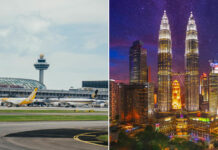SINGAPORE: It brought us services such as UberX, UberPool and UberPet. For millions of commuters worldwide, Uber has changed the face of transport, allowing people to find rides with an ease previously unheard of.
From a start-up in 2009, it has grown into one of the world’s most valuable private technology companies, valued at some US$62 billion (S$85 billion) today.
The behemoth made its foray into Southeast Asia with a launch in Singapore in 2013, followed by tiny start-up Grab later that year.
Five years later, however, the San Francisco-based firm conceded defeat and said goodbye to the region – its assets, offices and drivers now under the control of its rival.
Two became one, after Grab dethroned Uber.
The story of how a Singapore-based champion outgunned this ride-hailing giant is told in the new season of Inside the Storm – a series about how major companies are run, the high-pressure decisions and risks they take, and how they adapt in times of crisis.
A DISRUPTIVE, IRREVERENT COMPANY
Uber started out in San Francisco as UberCab, a limousine service that could be ordered via text or a tap of a button on one’s phone. It was an immediate hit.
Back then, there were numerous complaints about how expensive taxis were in the United States and how difficult it was to get them, said Assistant Professor Yang Nan of the National University of Singapore (NUS) Business School’s strategy and policy department.
Uber was a great alternative, as its location-based app made hiring an on-demand driver easy. “It was so successful because the industry there was ripe for disruption,” said Dr Yang.
The then CEO, Mr Travis Kalanick, set the culture for the company, with “this idea of a disruptive, irreverent company that wanted to break all the rules”, said former BBC correspondent Mark Worthington, now the managing director (Singapore) of Klareco Communications.
“It was probably that energy and originality that led to Uber’s very early and very rapid success.”
Between 2011 and 2014, Uber’s value jumped from US$60 million to US$17 billion as it expanded into 100 cities across North America, Europe, India, China, and Southeast Asia.
In 2012, Mr Vidit Agrawal became Uber’s first employee in Asia, at a time when few had heard of the brand in this region.
“When I told my parents I was going to join Uber, they were like, ‘Are you going to become a taxi operator?’” said Mr Agrawal, who started out as an operations manager in the company.
Uber’s expansion strategy of “go in, think later” involved scaling up rapidly and getting as many users and subscribers as it could.
The company did not, however, actively seek out and work with regulators, pointed out Nanyang Business School Adjunct Associate Professor Zafar Momin.
“That worked pretty well in the US”, but when Uber got to some markets in Europe and Asia, it “encountered a few difficulties”, he said. “One is that the regulatory framework wasn’t as kind or welcoming.”
NOT LOCAL ENOUGH
In addition, Uber lost its monopoly as copycat apps cropped up and competition heated up in all of its markets, such as Lyft and Gett in the US and Didi Chuxing in China.
In Southeast Asia, Grab had grand ambitions: To provide safe and convenient taxi services in Malaysia and the rest of the region.
Its co-founder Tan Hooi Ling recalled how, growing up in Malaysia, she constantly tried to convince her parents to let her take a taxi, as they were concerned she could be robbed or raped.
Grab co-founder Tan Hooi Ling (right).
“Because of certain bad apples in the system, the entire industry got a tremendously bad reputation. So we were trying to solve this from a holistic perspective,” she said.
The company carved out a niche for itself, focusing on local needs and cultures. A local understanding of the market is something that cannot be underestimated, said Mr Lim Kell Jay, the head of Grab Singapore.
“Every city is different, even within the same country,” he said. “So you need to understand all those nuances to serve your customers better.”
For example, recognising that many Southeast Asian cities had monstrous traffic jams, the firm unveiled GrabBike – motorcycle taxis that can weave in and out of traffic – in Vietnam, Indonesia and Thailand in 2014 and 2015.
While Uber cars were stuck in traffic, Grab cruised ahead in the market with their bikes. Uber eventually caught on – 17 months too late. That “hyper-local approach” was important, which a global company “sometimes takes for granted”, said Ms Tan.
READ: A quick ride out of poverty, thanks to ride-sharing apps
While Uber was designed for the global market, it did try to localise, said Mr Agrawal. But competitors like Grab and Go-Jek “had people (and) engineering teams on the ground, and their decision-making could’ve been a lot faster than ours”.
In under three years, Grab had expanded into 21 Southeast Asian cities. And by 2016, it had become a major competitor to Uber.
The latter also failed to understand that cash was king in Southeast Asia, accepting only credit cards for two years in some parts of the region before introducing cash payments, and it cost the firm dear.
Mr Lim noted: “We started out with cash, and that helped us tremendously in competing with the other players.”
DISTRACTED BY SCANDALS
Despite its efforts, Uber was falling behind in foreign markets. And it was being dogged by scandals – taxi companies have protested its presence in their cities, and it was banned in Delhi after one of its drivers raped a woman.
One of the many protests by taxi drivers against Uber.
Last year, when US President Donald Trump enforced the refugee ban, taxi companies joined American protesters at New York’s John F Kennedy International Airport in a show of solidarity, by refusing to pick up passengers.
But Uber continued operating and profited from the strike, a politically-laden decision that sparked the #DeleteUber campaign.
Barely a month later, the company was found using a software called Greyball, which barred certain individuals, including law enforcement officers, from using its service.
Around the same time, a video of Mr Kalanick berating an Uber driver went viral; and former Uber engineer Susan Fowler published a blog post accusing the firm of fostering a misogynistic corporate culture.
Video footage of Mr Travis Kalanick’s tiff with the driver.
An investigation report made 47 recommendations as to how to change its culture, and 20 employees were fired owing to a separate harassment probe.
Associate Professor Chu Junhong, from the NUS Business School’s department of marketing, said: “(There were) lots of PR crises. It really damaged the company’s public image.”
The issues of political alignment, profiteering, sexual harassment and the conduct of the CEO himself made last year a terrible one for Uber, noted Mr Worthington.
“When you’re hit by all of these in a short period of a few months, unless you do something very drastic, there’s always going to be a danger that what people are questioning isn’t the individual incident but the company as a whole.”
Grab, on the other hand, had an advantage over Uber when it came to staying out of trouble. It was “seen as friendlier – as, in some ways, more in tune with the needs of their customers”, he added.
With Uber spending resources putting out fires in the US, it left its other markets vulnerable. Mr Agrawal admitted: “It did affect the focus, and it also gave an opportunity to our competitors – Ola in India, to Grab.
“They weren’t leading the market, but they could easily focus on these markets. They doubled down on their initiatives and led a lot of the markets.”
PRICE WAR
In China, Uber’s grand plans to defeat homegrown company Didi Chuxing ended with its exit in 2016 and billions lost.
“Didi could concentrate all its resources in the Chinese market to compete with Uber, but Uber couldn’t concentrate all its resources in the Chinese market because Uber had so many markets to take care of,” said Dr Chu.
Its departure from China galvanised its Southeast Asian competitors. Said Mr Lim: “We started thinking, ‘Hey, a homegrown local company is able to overcome a global giant.’ And that’s when the belief started.”
Last year, Uber and Grab launched a price war. The end goal was presumably for one to force the other out of the market.
Dr Momin said: “It’s like having a fuse burning at both ends. And that’s a way to burn up cash very quickly, which is what happened for both companies.”
In March this year, Uber decided to exit Southeast Asia, with its competitor acquiring its operations and assets in eight countries, including Indonesia, Malaysia and Singapore, in exchange for a 27.5 percent stake in Grab.
Said Ms Tan: “It was a big milestone for us because it was a reinforcement (of our belief) that we were doing the right things and that the crazy journey we had started was worth it.”
READ: Grab buys Uber’s Southeast Asia operations: Who are the winners and losers?
Dr Momin does not see it as a failure on Uber’s part, however, but rather as the company trimming its portfolio to focus on a few countries, instead of “trying to fight a battle on so many fronts”.
“So in some ways it’s a smart move on the part of Uber,” he said. “It’s even good because it gets a stake in Grab, which now has a high valuation.”
While Grab is now a household name in Southeast Asia, its long-term profitability is questionable, as with that of Uber and Didi.
“If you take other disruptive companies like Amazon, they’d also lost money for a long time, but eventually they did start turning positive profits,” Dr Momin added.
“But Uber hasn’t turned positive profits; neither has Grab, and I don’t think Didi has either.”
READ: The Big Read: When the music stops, Uber-less reality hits commuters and drivers
For now, Grab can enjoy being the victor of a David and Goliath battle, whose outcome few would have predicted five years ago.
“We don’t take that good fortune lightly,” said Ms Tan. “We take it as a very significant responsibility because we’ve been fortunate to be able to do what we get to do now.”
Grab “did a very good job” of catching up with Uber, acknowledged Dr Yang.
“How it successfully operated here … catered for the local demand, understood the local market and designed products to fit the local demands – you have to give it credit.”
The new season of Inside the Storm tells the stories of the high-pressure decisions and risks taken by some of the world’s biggest brands: Uber, Apple, Haier, Japan Airlines and Starbucks. Watch the series here. Or catch episodes on Channel NewsAsia every Wednesday at 8pm.




